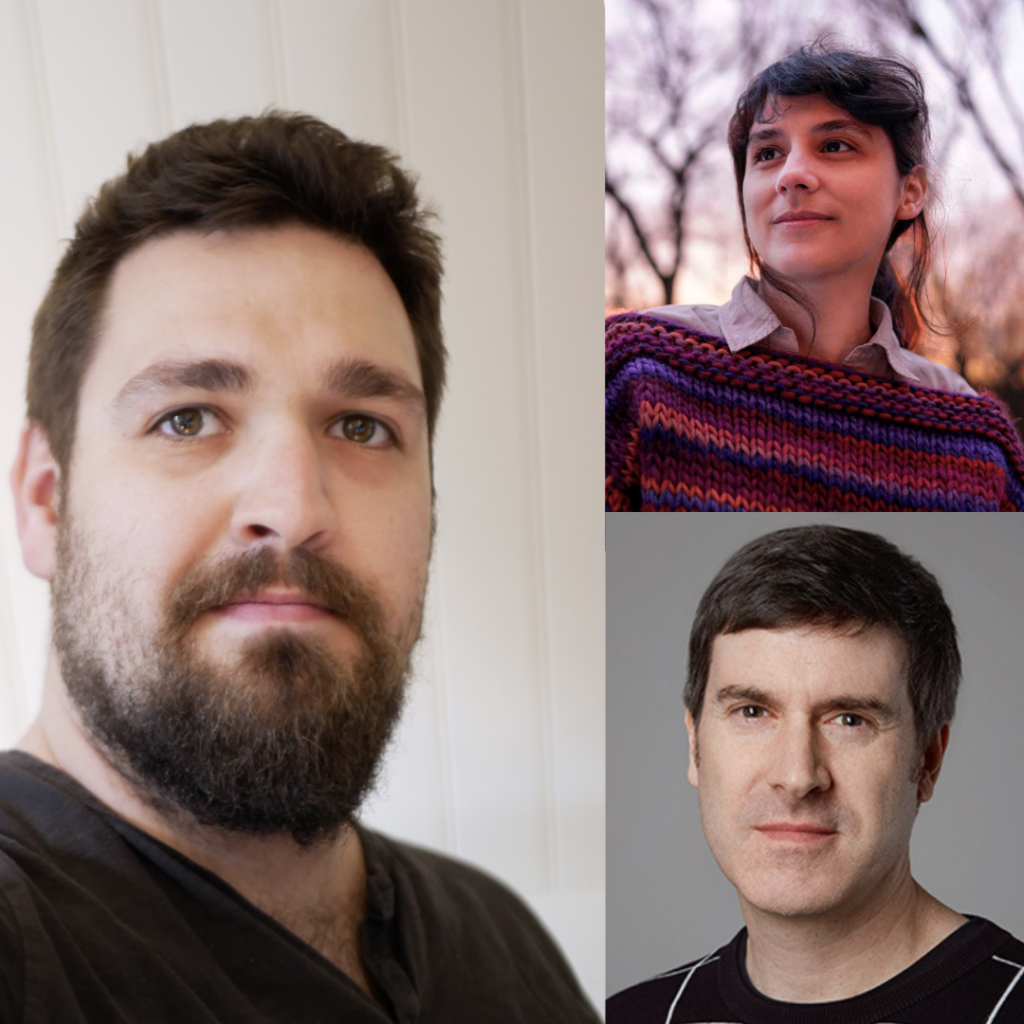Mêler les Arts, Sciences et Cultures: À L’écoute des Métamatériaux Acoustiques avec Georges Roussel
April 9, 2021
Stéphanie Ricci, Mathieu Aubin


See below for English version.
Cet hiver, Stéphanie et Mathieu ont eu le plaisir de discuter avec le groupe de chercheurs et artistes derrière le projet « Auxauralités ». Parmi cette équipe, Georges Roussel, Philippe Aubert-Gauthier, François Proulx et Nicolas Bernier présenteront leur exposé intitulé “Listening to Acoustic Metamaterials: A Futuristic Speculation on Acoustic Lens” au symposium de SpokenWeb “Listening, Sound, Agency” qui approche à grands pas. Voici notre entretien avec Georges qui nous parle plus en détail de son travail collaboratif sur les métamatériaux acoustiques.
Afin de vous présenter à nos lecteurs, pourriez-vous tout d’abord vous présenter et donner un bref aperçu de vos recherches ?
Le projet « Auxauralités » est composé d’un ensemble de chercheurs et d’artistes. Ana Dal’Ara Majek (artiste sonore) Georges Roussel (chercheur postdoctoral en acoustique au sein de GAUS [Groupe d’Acoustique de l’Université de Sherbrooke]), Philippe Aubert-Gauthier (ingénieur et Professeur en Arts Visuels et médiatiques à l’UQAM), forment le cœur du projet. D’autres membres tels que Nicolas Bernier (professeur à la faculté de Musique de l’université de Montréal), Julien Sylvestre (professeur à l’Université de Sherbrooke) et François Proulx (stagiaire en acoustique au baccalauréat à l’université de Sherbrooke) complètent cette équipe hybride.
« Auxauralités » est un projet qui mêle arts, sciences et cultures. Il permet d’aider (« Aux ») l’auditeur d’écouter à son environnement grâce à des oreilles (« Auralité ») artificielles, afin de se mettre à la place d’un autre auditeur, réel ou fictif. Le but de ce projet est de rassembler dans un même lieu des artistes et chercheurs en acoustique afin d’ouvrir de nouveaux horizons techniques pour les arts sonores, mais aussi d’autre part, d’apporter un nouveau cadre de réflexion pour la recherche acoustique, hors du contexte industriel souvent imposé. L’aspect pluridisciplinaire anime une part importante de ce projet de recherche en cherchant à faire disparaître la frontière entre les arts et les sciences. L’intégration des arts sonores directement en tant que contrainte technique dans le projet scientifique permet de mettre les arts au centre de la réflexion, avec les questions sociétales et esthétiques qui en découlent plutôt que de placer les arts en tant que commanditaire d’un besoin technique nécessaire à son avancement. Cet aspect de la recherche pousse les artistes et les chercheurs en acoustique hors des frontières usuelles de leur domaine de compétence. Les arts sonores se prêtent bien au cadre de recherche que nous proposons, les métamatériaux acoustiques. Ces matériaux permettent de modifier les caractéristiques physiques d’un son de façon précise et contrôlée par la matérialité des objets utilisés, permettant de s’affranchir de l’utilisation d’ordinateurs. Les objets sont fabriqués grâce aux méthodes d’impression 3D, ce qui permet une grande variété de formes permettant de remplir à la fois les critères artistiques et scientifiques des objets.
Qu’aimez-vous écouter ces derniers temps ?
Le projet et la situation ont grandement changé nos habitudes d’écoute. Pour ce qui est de Philippe-Aubert, il apprécie particulièrement les voix et les échos de la téléprésence que lui offrent ses nombreux projets. Ana pour sa part est restée enfermée pendant 12 jours pour écouter les métamatériaux en continu. On a hésité à lui greffer directement une oreille en métamatériaux, pour qu’elle puisse faire corps avec le projet. Georges, de son côté, a préféré écouter les sons qui sortaient de ses simulations physiques, avec de temps à autre une pause près de l’imprimante 3D pour écouter la symphonie des moteurs, pas à pas.
Dans votre résumé, vous vous référez aux “acoustic metamaterials,” et vous mentionnez que “sound is not in rest,” qu’entendez-vous par cet énoncé ?
Les métamatériaux forment une grande famille d’objets qui ne sont pas spécifiques au domaine de l’audible. Ils peuvent être utilisés par la physique des ondes en général, aussi bien pour les ondes électromagnétiques, telles que la lumière ou les ondes radio, mais aussi l’acoustique en général comme les ultrasons (domaine médical) ou les vibrations dans les solides (en géophysique, par exemple).
Ce qui se cache derrière notre expression ‘’Sound is not in rest’’ est à la fois pour dire que le domaine des métamatériaux acoustique est un domaine actif et éveillé, mais aussi pour faire comprendre que ces matériaux sont un ‘’challenge’’ pour les ondes acoustiques. En effet, les ondes sont contraintes d’avoir un comportement inhabituel à l’intérieur de ces matériaux, en comparaison avec les matériaux acoustiques classiques.
Pour effectuer votre recherche, travaillez-vous avec certaines collections d’enregistrements sonores ?
Pour ce projet, nous ne travaillons pas avec des collections sonores. Une partie de nos créations sonores sont issues d’enregistrements réalisés sur le terrain à l’aide de microphones dont la forme et le son sont modifiés par des métamatériaux acoustique. Nous utilisons aussi des sons issus de simulations physiques des métamatériaux que nous avons réalisés. Cette méthode d’écoute de simulations physique est appelée Auralisation.
Avez-vous un enregistrement sonore en particulier que vous aimeriez partager avec nos lecteurs ?
Oui, nous avons des enregistrements qu’il est possible de partager. Ces enregistrements sont issus de l’installation sonore présentée à Sporobole, à Sherbrooke dans le cadre du BetaLab. Le BetaLab permet aux artistes de présenter publiquement une œuvre, dans notre cas, une installation sonore, afin de valider son concept et sa réalisation technique. Les enregistrements présentés sont issus de l’installation sonore, mêlant enregistrements sur le terrain, sons issus de simulations physiques et interaction directe avec l’œuvre. Cette installation sonore inspirée du système auditif d’un animal imaginaire permet de rendre compte de la perception de l’environnement sonore lorsqu’il est modifié par les métamatériaux. C’est une pièce qui est, à notre sens, plus intéressante à écouter directement sans le contexte visuel et interactif de l’œuvre.
Merci Georges. Ce fut un plaisir!
___________________________________________________________________
English version:
Blending Arts, Sciences, and Cultures: Listening to Acoustic Metamaterials with Georges Roussel
This winter, Stéphanie and Mathieu had the pleasure of discussing with the group of researchers and artists behind the “Auxauralités” project. Among this team, Georges Roussel, Philippe Aubert-Gauthier, François Proulx, and Nicolas Bernier will be presenting their talk entitled “Listening to Acoustic Metamaterials: A Futuristic Speculation on Acoustic Lens” at SpokenWeb’s upcoming symposium “Listening, Sound, Agency.” We interviewed Georges to talk in greater detail about his collaborative work on acoustic metamaterials.
Could you introduce yourself to our readers and give a brief overview of your research?
The “Auxauralités” project is composed of a group of researchers and artists. Ana Dal’Ara Majek (sound artist), Georges Roussel (postdoctoral researcher in acoustics at GAUS [Groupe d’Acoustique de l’Université de Sherbrooke]), and Philippe Aubert-Gauthier (engineer and Professor in Visual and Media Arts at UQAM) are at the heart of the project. Other members such as Nicolas Bernier (Professor at the Faculty of Music of the University of Montreal), Julien Sylvestre (Professor at the University of Sherbrooke), and François Proulx (intern in acoustics at the University of Sherbrooke) complete the rest of this hybrid team.
“Auxauralities” is a project that mixes arts, sciences and cultures. It helps (“Aux”) the listener listen to their environment thanks to artificial ears (“Aurality”), to put themselves in the place of another listener, real or fictional. This project’s goal is to join artists and researchers in acoustics to open new technical horizons for the sound arts as well as to bring a new framework of reflection for the acoustic research outside the often imposed industrial context. This multidisciplinary aspect animates an important part of this research project by seeking to make the border between arts and sciences disappear.
The direct integration of sonic arts as a technical constraint in this scientific project makes it possible to put the arts at the centre of our project. Doing so enables us to carefully consider the societal and aesthetic questions that ensue from this research rather than perceiving the arts as simply a technical complementary aspect of our project’s advancement. This aspect of the research pushes artists and researchers in acoustics outside the usual boundaries of their field of expertise. The sound arts lend themselves well to the research framework we propose: acoustic metamaterials. These materials allow the physical characteristics of a sound to be modified in a precise and controlled way by the materiality of the objects without the use of computers. The objects are manufactured with 3D printing methods, which allows for a wide variety of shapes to meet both the artistic and scientific criteria of objects.
What do you like to listen to these days?
The project and the circumstances have greatly changed our listening habits. As for Philippe-Aubert, he particularly enjoys the voices and echoes of telepresence that his many projects offer him. Ana was locked up for 12 days to listen continuously to metamaterials. We hesitated to give her a metamaterial ear, so that she could literally be part of the project. Georges, on the other hand, preferred to stay and listen to the sounds that came out of his physical simulations, with an occasional break near the 3D printer to listen to the symphony of the motors one by one.
In your abstract, you refer to “acoustic metamaterials,” and you mention that “sound is not in rest,” what do you mean by this statement?
Metamaterials form a large family of objects that are not specific to the audible domain. They can be used by wave physics in general, both for electromagnetic waves, such as light or radio waves, but also for acoustics in general, such as ultrasound (in the medical field) or vibrations in solids (in geophysics, for example).
What is behind our expression ”Sound is not in rest” is not only to say that the field of acoustic metamaterials is active and awake but also to convey that these materials are a ”challenge” for acoustic waves. Indeed, the waves are forced to have an unusual behaviour inside these materials compared to classical acoustic materials.
When carrying out your research, do you work with certain sound recording collections?
For this project, we do not work with sound collections. Some of our sound creations come from recordings made in the field with microphones whose shape and sound are modified by acoustic metamaterials. We also use sounds from physical simulations of metamaterials we produced. This method of listening to physical simulations is called “Auralization”.
Do you have a particular sound recording that you would like to share with our readers?
Yes, we have recordings that can be shared. These recordings are from the sound installation presented at Sporobole in Sherbrooke as part of the BetaLab. The BetaLab enables artists to publicly present a work, in our case, a sound installation, in order to validate its concept and its technical realization. The recordings presented are from the sound installation, mixing field recordings, sounds from physical simulations and direct interaction with the work. This sonic installation, inspired by the auditory system of an imaginary animal, enables us to account for the perception of the sound environment when it is modified by the metamaterials. It is a piece that is, in our opinion, more interesting to listen to without the visual and interactive context of the work.
Thanks, Georges, for chatting with us, it’s been a pleasure!
